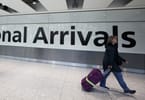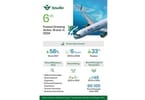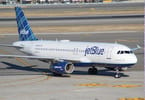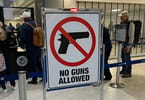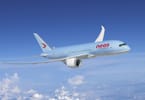In other circumstances, or other countries perhaps, the sequence of gestures might constitute an arrestable offence. The left hip goes up and then thrusts forwards until it almost touches a small, square panel. Then the right shoulder comes into play, nudging open the door. Another tea run successfully completed.
That is the daily ritual here at Independent House, as I return from the canteen loaded with enough tea for a party in Boston. But what might such pelvic gyrations have to do with your luggage? Read on.
Wednesday was, with one exception, a typical day for the baggage community. One in 60 pieces checked in at Europe’s airports will have failed to travel with their owners, judging from the latest figures from the Association of European Airlines (AEA). British Airways, in its perennial position at the bottom of the luggage league, misplaced rather more: for every fully loaded BA jumbo jet, eight pieces of baggage go astray.
The main cause: Heathrow, where the arbitrary array of terminals – and the fact that BA flies from three out of four of them – means that the scope for misrouting luggage is immense. Even BMI, with a single terminal and much smaller network, is fifth from last in the lost-bags league.
Missing luggage is costly for both travellers and airlines. For short-haul flights, it can often cost the carrier more to track down the case and deliver it than the fare the passenger paid. Eliminating such expense is the purpose of an experiment that started at Heathrow on Wednesday.
For the next six months, Emirates is trialling a new bag-tracking system. This much-delayed pilot programme is costing the Dubai-based airline £150,000, but the carrier hopes that it will pay for itself.
At present, every bag gets tagged with a bar code that is supposed to guide it through the labyrinthine network beneath the check-in area until it reaches the right plane. Or not – two out of five transfer bags at Terminal 3 at Heathrow are “misread” by the automatic system. Typically, they flip over on the baggage belt and conceal the bar code from the scanners.
A misread bag ends up at a chute where handlers have to inspect it and try to get it on to the correct flight. That sharply increases the risk that you will arrive in Jakarta only to find your bag is in Johannesburg.
The solution, hopes the airline, is based on radio frequency identification (RFID). This is the same technology that unlocks doors at The Independent, providing you perform the correct ungainly manoeuvre to get the wallet in your left-hand pocket that contains your ID card (with a built-in chip) close enough to the scanner.
RFID is also at the heart of the Oyster stored-value card that makes travel on London’s buses and Tube trains so much cheaper and easier than cash.
I understand that the system at Heathrow is more forgiving than the electronic locks at Independent House, and does not demand the same proximity. And because radio waves do not require visual contact, Emirates hopes far fewer bags will be mis-sorted and more of us will arrive at the same time and place as our luggage.
At present, it is a simple, closed system. Emirates has only a single destination from Heathrow: Dubai. Initially, the only prospective beneficiaries are the people booked on one of the five daily Emirates departures on Emirates from Heathrow to Dubai – perhaps 10,000 a week. They will notice no difference at check-in, and indeed, in a belt-and-braces exercise, the traditional bar-coded tag will still be applied.
A neat addition, though, when you’re flying inbound: if you register your mobile-phone number, you’ll get a text message when you arrive telling you which reclaim belt your bag is on.
You hope.
If RFID catches on, the prospect arises that airlines will know at every stage where each bag is – and potentially share that information with travellers. It will also help the loaders when they are sent into the jet’s hold to retrieve a bag belonging to a no-show passenger.
Before then, British Airways is hoping to start climbing up and away from the bottom of the European league.
When Terminal 5 enters service next month, the number of bags that get lost in translation between flights should fall: the £4.3bn terminal is actually built around the massive three-dimensional chess game that is its baggage transfer system.
If you prefer not to trust technology to protect your possessions when travelling by air, the easiest solution is: don’t check anything in. Most UK airports now allow more than one bag through security, though check that your airline permits two or more on board. (At Newquay, which still enforces the one-piece rule, I was obliged to check in a bag; it was – to use the opaque jargon of aviation – “short-shipped”, which means not shipped at all, but left behind in Cornwall.)
Second, if you must check bags in, try, if at all possible, to go for a direct flight. Air France and KLM join British Airways in the baggage relegation zone for the simple reason that they have “hub-and-spoke” networks based on Paris Charles de Gaulle and Amsterdam Schiphol respectively. You can sprint through the airport to make a tight connection, but don’t assume your checked-in bags will be fast-tracked to the waiting plane.
Next, assume all labels – and, indeed, handles – will be torn off. A label – or a strip of gaffer tape – stuck on a flat surface of the item is more likely to survive the tender caresses of baggage handlers and the automated luggage system. Stick another label inside the suitcase to avoid being one of the thousands who can’t be reunited with their bag because there is no way the airline can tell whose it is. (At this point, your best hope of getting it back is to head for Greasby’s auction house in Tooting, where much stray luggage ends up, and hope it comes under the hammer.) And never take anything that you are not prepared to lose.
You could, of course, choose an airline that loses the fewest bags. Ryanair – which does not belong to the AEA – claims to perform best. Among the Association’s members, Air Malta tops the table for care of its passengers’ bags. But the Maltese carrier also tops a less welcome league: the most-delayed airline in Europe. Perhaps the airline’s staff are just taking time to ensure that all the bags are safely stowed on board.
Plane truth: not only the passengers go ‘boing’
Technology helps to make flying incredibly safe. Very occasionally, though, I feel a twinge of unease. Last month, I was at Lima airport waiting for a flight to Iquitos. When the Star Peru aircraft finally turned up, an hour late, it was an early-model Boeing 737 that had seen a lot of action.
As the plane lined up for take off, the pilot found a fault; he taxied back to the terminal and we got off for another hour while the problem was fixed.
By the time we finally reached Iquitos, a storm of Amazonian proportions was raging. As lightning speared the sky, a couple of hundred feet from the ground the captain decided to abort the landing; the elderly engines shot us skywards again. The nearest diversion airport, Tarapoto, was an hour away. We sat on the ground while Saturday turned into Sunday.
Eventually, the crew learnt that the storm had cleared. At the time, I noted the aircraft’s serial number: OB-1841-P.
Safely home, I checked its chequered history. The plane was delivered 28 years ago to Britannia Airways.
After nine years of shuttling holidaymakers to the Mediterranean, the jet went west. Aloha Airlines flew the Boeing around the Hawaiian islands for most of 1990.
VASP of Brazil flew the jet in 1991, which was when it first paid a visit to the Amazon.
The prodigal plane returned to Britannia in 1992 for a couple more summers, then it was sold on to Ryanair. After 11 years, the Irish airline put it into retirement (appropriately enough in Bournemouth), until it was picked up 15 months ago by Star Peru.
During the trip I had plenty of time – and cause – to read the safety card. Given the aircraft’s bouncing history, it carries an appropriate misprint right at the top: “Boing 737”.
belfasttelegraph.co.uk
WHAT TO TAKE AWAY FROM THIS ARTICLE:
- This is the same technology that unlocks doors at The Independent, providing you perform the correct ungainly manoeuvre to get the wallet in your left-hand pocket that contains your ID card (with a built-in chip) close enough to the scanner.
- A misread bag ends up at a chute where handlers have to inspect it and try to get it on to the correct flight.
- At present, every bag gets tagged with a bar code that is supposed to guide it through the labyrinthine network beneath the check-in area until it reaches the right plane.





